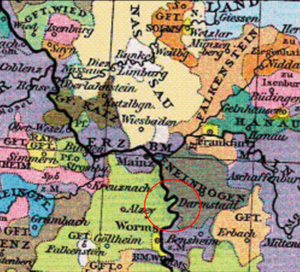Franckenstein reign
|
Territory in the Holy Roman Empire |
|
|---|---|
| Frankenstein | |
| coat of arms | |

|
|
| map | |
| Arose from | Merging of goods belonging to the Breuberg and Weiterstadt families.
Around 1240: Frankenstein Castle was built , 1402: Castle area and Nieder-Beerbach office became imperial |
| Form of rule | Domination |
| Ruler / government | Nobleman |
| Today's region / s |
DE-HE
|
| Reichskreis | Imperial Knighthood |
| Capitals / residences | Frankenstein Castle |
| Dynasties | Breuberg (noble family) |
| Denomination / Religions | Roman Catholic |
| Language / n |
German
|
| Incorporated into | 1662: Landgraviate of Hessen-Darmstadt
|
The Franckenstein dominion was a historical territory in the northern Odenwald . It was created around 1230 from the possession of the charms of Breuberg , the center of which was Frankenstein Castle . Konrad II. Reiz von Breuberg and his wife Elisabeth von Weiterstadt . After the castle was built, they were called Franckenstein (also Frankenstein ) from then on . The rule remained in the family's possession as a condominium until 1662. After the Frankensteiner was sold to Landgrave Ludwig VI. (Hessen-Darmstadt) , it came into the possession of Hessen-Darmstadt.
history
Breuberg
Franckenstein
Wiknand von Luetzelbach was the ancestor of the Frankenstein family and is first mentioned in a document in 1160.
His grandson Konrad I and his descendants built the Breuberg Castle of the same name around 1200 and subsequently called themselves Herren von Breuberg . Through the marriage of his son Eberhard I. Reiz von Breuberg to Mechtild (Elisabeth?), One of the five heir daughters of Bailiff Gerlach II von Büdingen, in 1239 power, property and interests also shifted to the Wetterau , where the Breuberger Arrois, Konrad, Gerlach and Eberhard III. successively held the office of bailiff of the Wetterau.
Konrad II. Reiz von Breuberg or Konrad I von Frankenstein built the family castle probably around 1240, named himself after her from then on and thus became the founder of the Frankenstein rule.
territory
The territory of the Frankensteiner comprised possessions in Nieder-Beerbach , Eberstadt , Ockstadt (with Ockstadt Castle ) near Friedberg, the Wetterau and the Hessian Ried . Eberstadt (now part of Darmstadt ), Nieder-Beerbach (now part of Mühltal ), Ober-Beerbach (now part of Seeheim-Jugenheim ), Schmal-Beerbach (now part of Lautertal ), Stettbach (now part of Seeheim-Jugenheim ) were under the Frankenstein rulership (overlords) ), Allertshofen (now part of Modautal ), Bobstadt , Ockstadt and parts of Weiterstadt . In addition, the Frankensteiners had further ownership and lordship rights as burgraves in Zwingenberg ( Auerbach Castle ), Darmstadt, Groß-Gerau ( Dornberg Castle ), Bensheim and Frankfurt am Main , which are still reminiscent of Frankensteiner Platz and Frankensteiner Straße in the Sachsenhausen district.
The dominion in the northern Odenwald was probably already established when the documentary tradition began in 1252. However, the wording of the document “super castro in frangenstein” (“on the castle on the Frankenstein”) shows that the castle had already been built and was in use at that time. The exact time of origin is uncertain; Conjectures go back to Franconian times .
condominium
In the course of the 14th century, the Frankenstein family split into two lines. They then divided the castle after a meticulously described truce of 1363. Nevertheless, constant legal disputes between the two lines were the result.
Around the year 1400 the influence of the Frankensteiner increased. The castle, which had become too small, was massively expanded and modernized around the outer bailey. In 1402 the castle, together with Nieder-Beerbach, became an imperial fief or imperial direct .
literature
- J. Friedrich Battenberg: Roßdorf in premodern times. Everyday life and culture of conflict in a rural Hessian community in the 17th and 18th centuries. In: Archive for Hessian History and Archeology , Vol. NF 60 (2002), ISSN 0066-636X , pp. 29–60.
- Roman Fischer: Finding aid for the holdings of Frankenstein fiefdoms 1251–1812. Kramer, Frankfurt am Main 1992, ISBN 3-7829-0433-8
- Hellmuth Gensicke : Investigations into the genealogy and property history of the lords of Eschollbrücken, Weiterstadt, Lützelbach, Breuberg and Frankenstein. In: Hessische Historische Forschungen (1963), pp. 99–115.
- Rudolf Kunz: Village regulations of the Franckenstein rule from the 2nd half of the 16th century. Reprint from: Archives for Hessian History and Archeology. Volume 26, Issue 1, 1958.
- Wolfgang Weißgerber: The gentlemen of Frankenstein and their women: landscapes, people, stories . Schlapp, Darmstadt-Eberstadt 2002, ISBN 3-87704-050-0 .
- Karl Otmar Freiherr von Aretin: Franckenstein, barons from and to. In: New German Biography (NDB). Volume 5, Duncker & Humblot, Berlin 1961, ISBN 3-428-00186-9 , p. 329 ( digitized version ).
- Anke Stößer: Lords between the Rhine and the Odenwald. In: Knights, Counts and Princes - secular rulers in the Hessian area approx. 900–1806 (= Handbook of Hessian History 3 = Publications of the Historical Commission for Hesse 63). Marburg 2014, ISBN 978-3-942225-17-5 , pp. 152-170, especially pp. 163-165
- (Ed.) Geschichtsverein Eberstadt / Frankenstein: Reader on the history of Frankenstein. Burg - Herrschaft - Familie , Darmstadt-Eberstadt 2018.
Individual evidence
- ^ A b Wolfgang Weißgerber: The gentlemen of Frankenstein and their women: Landscapes, people, stories, Darmstadt-Eberstadt, Schlapp 2002; ISBN 3-87704-050-0 .
- ↑ M. Stimmlng, Mainzer Urk.- Book I 1932 No. 586 and 6 (5).
- ↑ a b http://www.eberstadt-frankenstein.de/content/014a_herrschaft_frankenstein_lat.pdf Battenberg, Friedrich: “Castle and Lordship of Frankenstein in premodern times, lecture at the ceremony for the 750th anniversary of the first documentary mention of Frankenstein Castle on August 16 2002 "
- ↑ [1] According to the publication of the history association Eberstadt-Frankenstein eV




